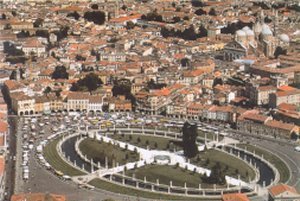National Mall Third Century Initiative
"There are a few times in a city's history when a window opens and the fresh breeze of the future blows in. Like 1901, this [2006] is one of those moments."
-- Washington Architect Arthur Cotton Moore
Last night at the Corcoran Gallery of Art, I attended the planning meeting of the National Mall Third Century Initiative, which seeks to build upon, and expand significantly in scope, the two prior planning documents which have governed the development of the civic, monumental, and cultural core of Washington, D.C. over the past more than 200 years -- the 1791 L'Enfant Plan and the 1901-1902 McMillan Plan.
Architect Arthur Moore unveiled a plan reconfiguring the banks of the Potomac River and creating a second North - South Mall. He also envisioned how the current Haines Point Recreation area could be turned into a place for civic forums and cultural institutions. His design concept drew significantly upon Padua, Italy's Prato della Valle civic architecture and watercourse.
My own public comments last night focused on the need properly to conceptualize national museum requirements in Washington's Third Century -- and especially on the role that a major National History and Democracy Museum could play in the reinvigoration of the civic axis running South from the Washington Monument to the poorly developed area South and East of the Jefferson Memorial. (According to the National Capitol Planning Commission, the U.S. Supreme Court has also expressed an historic interest in a future development site due south from the White House, the Washington Monument, and the Jefferson Memorial -- a design concept of the 1901-1902 McMillan Plan.)
The meeting also addressed the politics of creating a public-private Conservancy -- modeled on those of New York City's Central Park and San Francisco's Golden Gate Park -- to integrate the funding and governing of the maintenance and space use of the National Mall in Washington, D.C.
Besides the plan of Arthur Cotton Moore, I responded strongly to the design concepts and ideas of the experienced Washington architect W. Kent Cooper (a founder of the National Mall Third Century Initiative), the younger Washington architect Richard Schneider whose young firm I thought had most thoroughly thought through Mall expansion issues, and American civic planning historian Richard Longstreth.
National Mall Third Century Initiative http://www.nationalmall.net/

The Renaissance-era Prato della Valle civic monument and watercourse in Padua, Italy.
Photo credit:
-- Washington Architect Arthur Cotton Moore
Last night at the Corcoran Gallery of Art, I attended the planning meeting of the National Mall Third Century Initiative, which seeks to build upon, and expand significantly in scope, the two prior planning documents which have governed the development of the civic, monumental, and cultural core of Washington, D.C. over the past more than 200 years -- the 1791 L'Enfant Plan and the 1901-1902 McMillan Plan.
Architect Arthur Moore unveiled a plan reconfiguring the banks of the Potomac River and creating a second North - South Mall. He also envisioned how the current Haines Point Recreation area could be turned into a place for civic forums and cultural institutions. His design concept drew significantly upon Padua, Italy's Prato della Valle civic architecture and watercourse.
My own public comments last night focused on the need properly to conceptualize national museum requirements in Washington's Third Century -- and especially on the role that a major National History and Democracy Museum could play in the reinvigoration of the civic axis running South from the Washington Monument to the poorly developed area South and East of the Jefferson Memorial. (According to the National Capitol Planning Commission, the U.S. Supreme Court has also expressed an historic interest in a future development site due south from the White House, the Washington Monument, and the Jefferson Memorial -- a design concept of the 1901-1902 McMillan Plan.)
The meeting also addressed the politics of creating a public-private Conservancy -- modeled on those of New York City's Central Park and San Francisco's Golden Gate Park -- to integrate the funding and governing of the maintenance and space use of the National Mall in Washington, D.C.
Besides the plan of Arthur Cotton Moore, I responded strongly to the design concepts and ideas of the experienced Washington architect W. Kent Cooper (a founder of the National Mall Third Century Initiative), the younger Washington architect Richard Schneider whose young firm I thought had most thoroughly thought through Mall expansion issues, and American civic planning historian Richard Longstreth.
National Mall Third Century Initiative http://www.nationalmall.net/

The Renaissance-era Prato della Valle civic monument and watercourse in Padua, Italy.
Photo credit:


0 Comments:
Post a Comment
<< Home